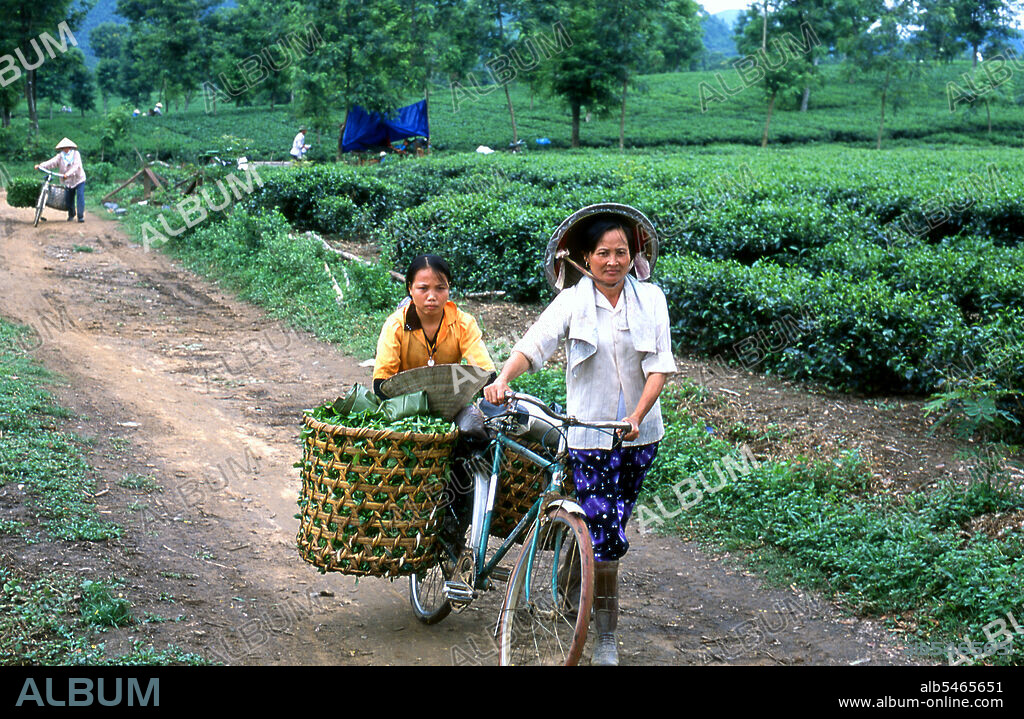alb5465651
Vietnam: Transporting freshly picked tea leaves, tea plantation near Thanh Son, Phu Tho Province, northwest Vietnam

|
Ajouter à une autre Lightbox |
|
Ajouter à une autre Lightbox |



Avez-vous déjà un compte? S'identifier
Vous n'avez pas de compte ? S'inscrire
Acheter cette image.
Sélectionnez l'usage:

Titre:
Vietnam: Transporting freshly picked tea leaves, tea plantation near Thanh Son, Phu Tho Province, northwest Vietnam
Légende:
Voir la traduction automatique
According to oral tradition, tea has been grown in China for more than four millennia. The earliest written accounts of tea making, however, date from around 350 CE, when it first became a drink at the imperial court. Around 800 CE tea seeds were taken to Japan, where regular cultivation was soon established. Just over five centuries later, in 1517, tea was first shipped to Europe by the Portuguese soon after they began their trade with China. In 1667 the Honourable East India Company ordered the first British shipment of tea from China, requesting of their agents ‘one hundred pounds weight of the best tey that you can get’. In 1826 the Dutch bought seeds from Japan for cultivation in their growing East Indian Empire, supplementing this effort in 1833 by imports of seeds, workers and implements from China. Meanwhile, also in the 1830s, the East India Company began growing tea on an experimental basis in Assam – the first one hundred boxes of Assamese tea reached Britain in 1840, and found a ready market. About the same time, tea seedlings were transplanted from Assam to Sri Lanka and planted in the highlands around Kandy. By the beginning of the present century tea was very much in fashion, with plantations established as far afield as Vietnam in Southeast Asia, Georgia in Europe, Natal, Malawi, Uganda, Kenya, Tanzania and Mozambique in Africa, Argentina, Brazil and Peru in South America, and Queensland in Australia. Despite this proliferation, however, Sri Lanka remains the largest producer of tea in the world today, with the fragrant black leaf the mainstay of its economy.
Crédit:
Album / Pictures From History/Universal Images Group
Autorisations:
Taille de l'image:
5210 x 3390 px | 50.5 MB
Taille d'impression:
44.1 x 28.7 cm | 17.4 x 11.3 in (300 dpi)
Mots clés:
AGRICULTURE • AGRICULTURE: MOISSON • ASIE • ASIE, CONTINENT • BATTEUSE • BICYCLE • BICYCLETTE • BOIRE • BOISSON • CAMPAGNE MOISSON • CONTINENT ASIE • CUEILLETTE • CUEUILLETTE • CYCLE • FEMELLE • FEMM • FEMME • FEUILLE • FEUILLE, MOTIFS • FEUILLES • FLORE • HISOIRE • HISTOIRE • MOISSON • MOTIFS, FEUILLE • PLANTATION • PLANTE • PLANTE: FEUILLE • RECOLTE • TRANSPORT BICYCLETTE • VEGETAUX • VIETNAM • VIETNAMIEN


 Pinterest
Pinterest Twitter
Twitter Facebook
Facebook Copier le lien
Copier le lien Email
Email
